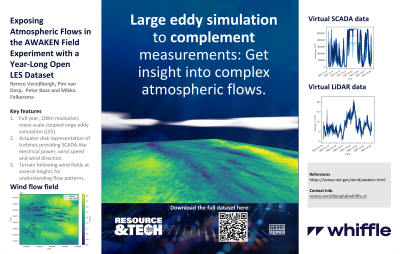Back

Exposing Atmospheric Flows in the AWAKEN Field Experiment with a Year-Long Open LES Dataset.
Tuesday, October 1, 2024
5:00 PM – 6:00 PM MST
Location: Regency D


Remco Verzijlbergh
Co-Founder & CEO
Whiffle
Delft, Zuid-Holland, Netherlands
Poster Presenter(s)
Presentation Description: The American Wake Experiment (AWAKEN) is a unique and large-scale field experiment aimed at a better understanding of wind farm wake effects. The measurement campaign contains numerous observations, ranging from LiDARs to sonic anemometers and radars, covering practically all atmospheric processes relevant for wind farm wakes. Despite being probably the most intensively equipped wind farm site around the globe, high-fidelity atmospheric models can still provide a useful complement to the measurement data. In this presentation we present results from a year-long Large-Eddy Simulation (LES) run that encompasses all wind turbines and measurement locations of the entire AWAKEN campaign.
We explain the set-up of the LES model, which covers all turbines and measurement locations in AWAKEN. Turbines are modeled as actuator disks, with turbine specific power and thrust curves. Boundary conditions to the LES model come from a concurrent mesoscale model which is itself driven with ERA5 boundaries.
In the results section we perform a basic validation against some of the LiDARs and other observations. The model is found to capture the turbulent structure of the atmosphere well, both in ambient conditions and wake regions. In our analysis of the LES results, we focus on the atmospheric phenomena relevant for wakes: atmospheric stability, turbulence (ambient and wake added), low-level jets, boundary layer height, shear and veer. We also demonstrate the strength of year-long and spatially large LES dataset to capture the atmospheric phenomena mentioned above in a statistically meaningful way. The dataset is released as open dataset for the wind energy community as a cloud-native data storage format that facilitates easy analysis.
We explain the set-up of the LES model, which covers all turbines and measurement locations in AWAKEN. Turbines are modeled as actuator disks, with turbine specific power and thrust curves. Boundary conditions to the LES model come from a concurrent mesoscale model which is itself driven with ERA5 boundaries.
In the results section we perform a basic validation against some of the LiDARs and other observations. The model is found to capture the turbulent structure of the atmosphere well, both in ambient conditions and wake regions. In our analysis of the LES results, we focus on the atmospheric phenomena relevant for wakes: atmospheric stability, turbulence (ambient and wake added), low-level jets, boundary layer height, shear and veer. We also demonstrate the strength of year-long and spatially large LES dataset to capture the atmospheric phenomena mentioned above in a statistically meaningful way. The dataset is released as open dataset for the wind energy community as a cloud-native data storage format that facilitates easy analysis.
